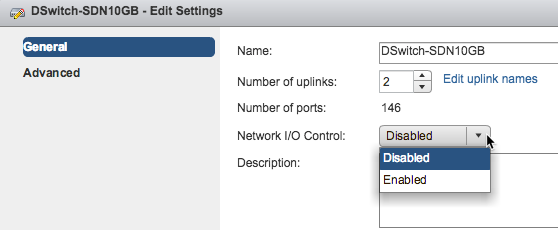Still, you have to work in the same network inventory view. You will see the vDS created before and you can simply select it, then choose the Configure tab and the Properties menu to see all the settings of your vDS:

General properties vDS
You can change the settings by clicking on Edit in the right corner. Distributed switched settings are grouped in a general part (for the common settings) and in an advanced part (for the advanced settings):
- General: You can change the name of the vDS, change the number of uplinks (and their names), enable or disable network I/O control or add a description to your vDS:

General vDS
- Advanced: Advanced settings include the possibility to change the MTU, multicast filtering mode, discovery protocol, and add administrator contact. Under Multicast filtering mode, you can set the filtering mode as follows:
- Basic filtering: In basic multicast filtering mode, a vSS or vDS forwards multicast traffic for VMs according to the destination MAC address of the multicast group.
- Multicast snooping: In the multicast snooping mode, a vDS provides IGMP and MLD snooping according to RFC 4541. For more details refer to https://tools.ietf.org/html/rfc4541.

Advanced vDS
-
- Discovery protocol: There are two different supported protocols. First is Cisco Discovery Protocol (CDP), proprietary from Cisco, but supported also by some other switches. The second is a vendor-neutral standard called Link Layer Discovery Protocol (LLDP). Note that vSS supports only CDP. You can choose the discovery protocol, and if it is enabled you can choose also in which directory it can be used (advertise, to announce at the physical switch, or listen, to receive information from the physical switch):

Discovery protocol
